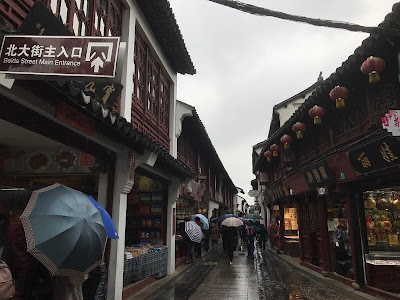The first structure we saw is a bell tower.
As it started to drizzle, we took a short break under the shelter where there were lots of wishing amulets hanging all over the place.
Below is a map of QiBao Ancient Town. We started our exploring this town from the northern street.
Visitors who are interested can rent costumes for photo taking in this ancient town.Javier suddenly had a craving for Xiao Long Bao (小笼包) so we stopped by a place to have the authentic Xiao Long Bao.
It was a great feeling to enjoy the hot dumplings and Xiao Long Bao in such a cold weather.
We continued to explore the town after the quick bites.
Qibao is the closest water town to Shanghai. In fact, I did not know there is such an ancient water town within Shanghai till we did our research about Shanghai before the trip. Most people are only aware of those water towns that are in the outskirt cities such as Suzhou and Hangzhou.
Anyway, we were glad that we found this place as we do not have plan to visit other water towns which are not so easily accessible without going on a local tour.There were several bridges built across the Puhui River (蒲汇塘) that link to the other side of the town,
Qibao town was built in Northern Song Dynasty (960-1126) and grew into a prosperous business center during Ming (1368-1644) and Qing Dynasties (1644-1911). There are two theories on how the name of this town comes about. The more reliable one says that the name originates from the Qibao Temple, famed for its good reputation. The other theory seems more popular among the local people who tell folk tales about "seven treasures" (which is what 七宝 means).
Qibao Temple (七宝寺), with its ingenious designs for both buildings and gardens, presents visitors with an insight of the unique architectural styles of Han (BC206-220) and Tang Dynasty (618-907).
Qibao Old Street is divided into the two sections: the southern street and the northern street. The south street features with local snack. It homes many delicious snacks all over China. The north street is given priority to with tourism souvenirs, including antiques, calligraphy and paintings. Qibao Old Street has become a busy street that combines leisure, tourism, shopping as a whole.
After enjoying the beautiful scenery around, Javier again asked for Xiao Long Bao! Since we were along the southern street with all sorts of local snacks, we entered a stall which sells Xiao Long Bao.
Xiao Long Bao was not sufficient to satisfy our taste buds. There were simply too many "attractive" local snacks along the street.I have read a lot about beggar chicken (叫花鸡) from Chinese Martial Arts Novels but today I finally got to see it in real life.
Jerlene and Javier bought their favourite sugar coated haws on sticks (冰糖葫芦).
We spent about 3 hours in Qibao Town before taking the metro back to Hong Qiao.
As it's winter now, sunset was very early. The sky started to turn dark before 5pm.





































No comments:
Post a Comment